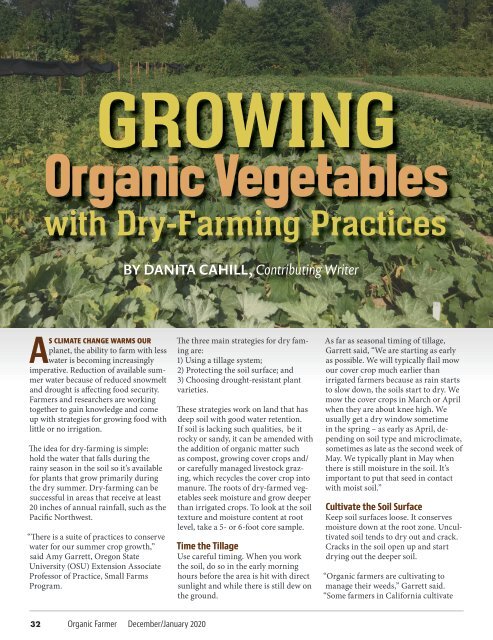OF Dec Jan 2020
Create successful ePaper yourself
Turn your PDF publications into a flip-book with our unique Google optimized e-Paper software.
GROWING<br />
Organic Vegetables<br />
with Dry-Farming Practices<br />
BY DANITA CAHILL, Contributing Writer<br />
As climate change warms our<br />
planet, the ability to farm with less<br />
water is becoming increasingly<br />
imperative. Reduction of available summer<br />
water because of reduced snowmelt<br />
and drought is affecting food security.<br />
Farmers and researchers are working<br />
together to gain knowledge and come<br />
up with strategies for growing food with<br />
little or no irrigation.<br />
The idea for dry-farming is simple:<br />
hold the water that falls during the<br />
rainy season in the soil so it’s available<br />
for plants that grow primarily during<br />
the dry summer. Dry-farming can be<br />
successful in areas that receive at least<br />
20 inches of annual rainfall, such as the<br />
Pacific Northwest.<br />
“There is a suite of practices to conserve<br />
water for our summer crop growth,”<br />
said Amy Garrett, Oregon State<br />
University (OSU) Extension Associate<br />
Professor of Practice, Small Farms<br />
Program.<br />
The three main strategies for dry faming<br />
are:<br />
1) Using a tillage system;<br />
2) Protecting the soil surface; and<br />
3) Choosing drought-resistant plant<br />
varieties.<br />
These strategies work on land that has<br />
deep soil with good water retention.<br />
If soil is lacking such qualities, be it<br />
rocky or sandy, it can be amended with<br />
the addition of organic matter such<br />
as compost, growing cover crops and/<br />
or carefully managed livestock grazing,<br />
which recycles the cover crop into<br />
manure. The roots of dry-farmed vegetables<br />
seek moisture and grow deeper<br />
than irrigated crops. To look at the soil<br />
texture and moisture content at root<br />
level, take a 5- or 6-foot core sample.<br />
Time the Tillage<br />
Use careful timing. When you work<br />
the soil, do so in the early morning<br />
hours before the area is hit with direct<br />
sunlight and while there is still dew on<br />
the ground.<br />
As far as seasonal timing of tillage,<br />
Garrett said, “We are starting as early<br />
as possible. We will typically flail mow<br />
our cover crop much earlier than<br />
irrigated farmers because as rain starts<br />
to slow down, the soils start to dry. We<br />
mow the cover crops in March or April<br />
when they are about knee high. We<br />
usually get a dry window sometime<br />
in the spring – as early as April, depending<br />
on soil type and microclimate,<br />
sometimes as late as the second week of<br />
May. We typically plant in May when<br />
there is still moisture in the soil. It’s<br />
important to put that seed in contact<br />
with moist soil.”<br />
Cultivate the Soil Surface<br />
Keep soil surfaces loose. It conserves<br />
moisture down at the root zone. Uncultivated<br />
soil tends to dry out and crack.<br />
Cracks in the soil open up and start<br />
drying out the deeper soil.<br />
“Organic farmers are cultivating to<br />
manage their weeds,” Garrett said.<br />
“Some farmers in California cultivate<br />
32 Organic Farmer <strong>Dec</strong>ember/<strong>Jan</strong>uary <strong>2020</strong>


















